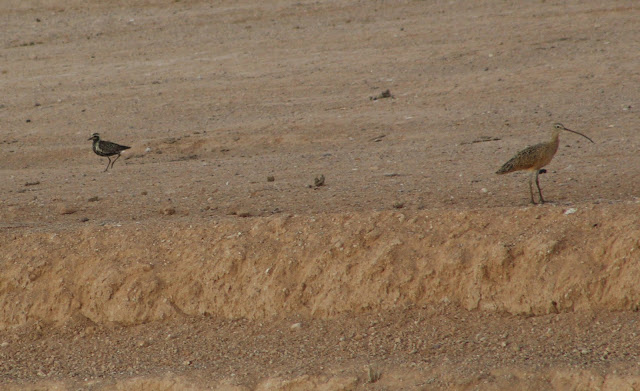Fall is upon us and this fall has been turning up some interesting birds in Arizona. It hasn't come close to matching the amount of rarities that were found in the state last fall, and I haven't expected it to. Recently, Jake Mohlmann and a group of birders stopped by Roosevelt Lake to do some birding. While at the Bermuda Flat Recreation Site at the lake, they found a first year Long-tailed Jaeger. They documented the bird well, and it will become the 380th species for the Gila County list when it is updated next. The birding group found the Jaeger in the early afternoon, and chasers weren't able to re-find the bird later in the day. It took a determined Chris McCreedy, who was one of the birders who dipped on the Jaeger on his initial chase, to bird the lake on the following day, September 9th. Chris rented a boat and not only found the young Jaeger near where it was found on the previous day, but he also found an adult Long-tailed Jaeger with it. Two birds on Roosevelt Lake, Gila County, was astounding news. I was planning on enjoying it vicariously. While I got the news of the birds, I was birding at the Glendale Recharge Ponds with my buddy Ronnie Reed. Ronnie didn't want to enjoy the Jaegers vicariously, and before I knew it, we were going up to Roosevelt Lake and stopped birding at Glendale immediately.
Ronnie and I got to Roosevelt Lake at about 11:30 A.M., and once we got there, we went straight to the boat launch by Cholla Campground. Adrian Smith was there before us, and he kindly waited for us. As we were about 15 minutes away, Adrian texted the birding group chat that he was looking at one of the Jaegers. Ronnie and I rolled up and got to see the bird through the scope immediately. We watched it for a few minutes, and got to study it sitting on the water and in flight. While the views were all there to be consistent with the first year Long-tailed Jaeger, we did want much better views than the distant ones we were having. Other birders were on their way, and between Ronnie, Adrian, me, and some of those who were coming, we were interested in meeting up to share a boat rental. This would allow us several hours of birding Roosevelt Lake by boat, and would give us a much better chance at the looks we wanted of the Jaegers. We were joined by Brian Johnson, Cathy Beck, Dara Vazquez, and Steve Valasek to have seven pairs of eyes looking for birds. Once we rented the boat, Ronnie was the captain and drove us around. Ronnie got us where we needed to go, and he kicked ass at being captain.
As we went north from the marina, it didn't take long to cross paths with that juvenile Long-tailed Jaeger. Adrian spied it once again, and as we made our way toward it, the Jaeger was as cooperative as can be.
After having the thrill of finding Jaeger so quickly, we went as far north as we could go on the lake, and then went almost as far south as we could go on the lake. Roosevelt Lake is huge, and is Arizona's largest reservoir that is solely in Arizona. As we got close to the southern side of the lake, Steve spied the adult Long-tailed Jaeger. The sight of an adult was epic, and it took more work to get good looks at. This Jaeger was on the move a lot more, but did give us great looks a few times as it flew right by the boat.
After getting observations in of the adult, we encountered it again with "the" juvenile. At first we thought it was the same juvenile as before, but we realized later that this one was a lighter juvenile, and the first one was more intermediate in color. It was neat to say that we saw three Long-tailed Jaegers at Roosevelt Lake in Gila County. The result was incredible, and the numbers like this seem unheard of in lakes within central Arizona. The waters of the Lower Colorado River in western Arizona get Jaegers almost annually when people are looking. One has gotta wonder how many Jaegers aren't found in Arizona....dang.....
Other cool birds we saw included an adult and juvenile Sabine's Gull, Forster's Terns, lots of Red-necked Phalaropes, California Gull, and scads upon scads of Western and Clark's Grebes. One bird that got away was brief look at a heron that appeared to be a Reddish Egret who flew out and back into dense cover.
It turns out the Jaeger party got only better after we left. The following day had birders finding a dark morph juvenile Long-tailed Jaeger, which equaled out to be an astonishing four birds in less than 24 hours. The dark juvenile could've been there when we were there too, of course. As I said earlier, Roosevelt is a huge lake, and it's easy to miss things. Juvenile Long-tailed Jaegers have three color morphs of intermediate, light, and dark. Intermediate birds account for about 50% of the population, light birds about 20%, and dark birds about 30%. Adult Long-tailed Jaegers are always light, with no dark morph (Sibley).
After I wasn't planning on going up to the lake, I was glad I did and I enjoyed the heck out of birding Roosevelt by boat for the first time. It was awesome to bird Gila County after a long time of not exploring it. Thanks to everyone who joined the expedition, and to Ronnie for the trip. As for Long-tailed Jaegers and Jaegers in general, who knows how many of them really show up throughout Arizona after seeing this show...


































